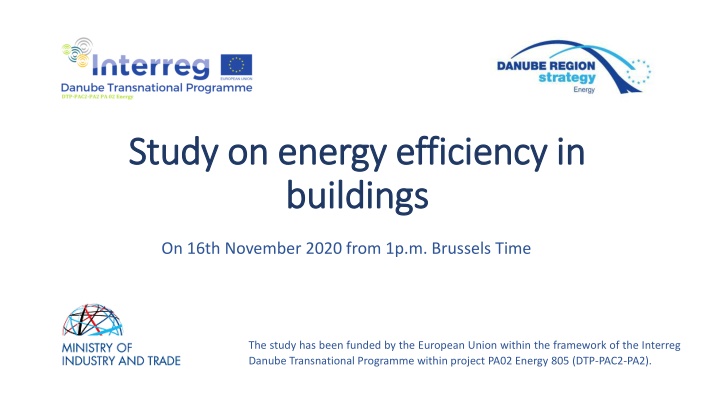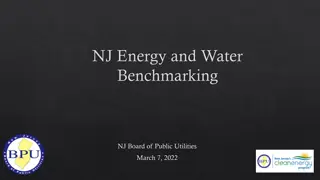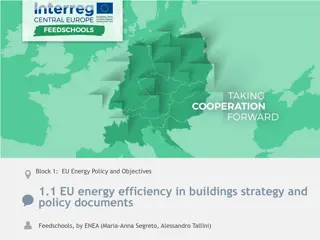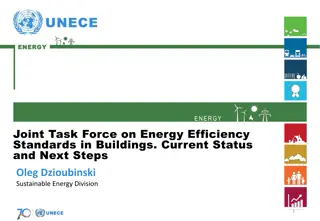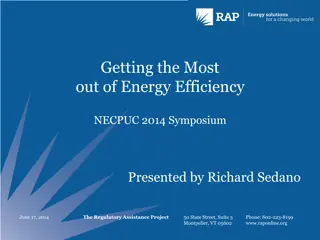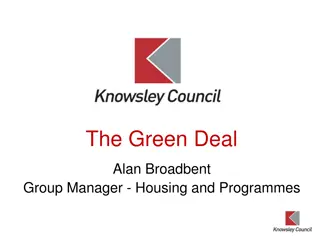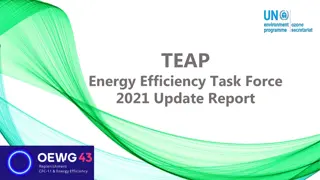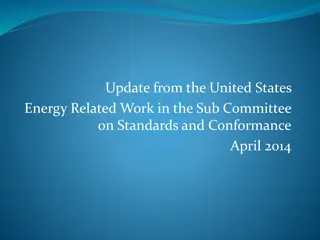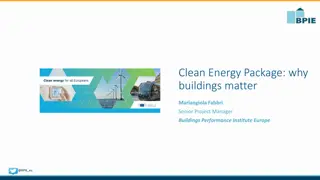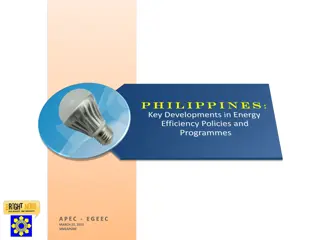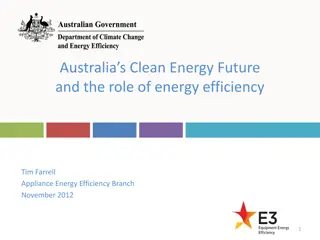Energy Efficiency in Buildings: Study and Analysis
Explore a comprehensive study on energy efficiency in buildings, funded by the European Union under the Interreg Danube Transnational Programme. The research delves into the energy performance of buildings in the Danube Region, emphasizing the overview of residential building stocks and energy consumption trends. Detailed insights are provided on different aspects such as regulatory frameworks, renovation rates, and comparison of collected data, concluding with compliance documents and identified barriers.
Uploaded on Sep 24, 2024 | 3 Views
Download Presentation

Please find below an Image/Link to download the presentation.
The content on the website is provided AS IS for your information and personal use only. It may not be sold, licensed, or shared on other websites without obtaining consent from the author.If you encounter any issues during the download, it is possible that the publisher has removed the file from their server.
You are allowed to download the files provided on this website for personal or commercial use, subject to the condition that they are used lawfully. All files are the property of their respective owners.
The content on the website is provided AS IS for your information and personal use only. It may not be sold, licensed, or shared on other websites without obtaining consent from the author.
E N D
Presentation Transcript
Study on energy efficiency in Study on energy efficiency in buildings buildings On 16th November 2020 from 1p.m. Brussels Time The study has been funded by the European Union within the framework of the Interreg Danube Transnational Programme within project PA02 Energy 805 (DTP-PAC2-PA2).
Energy Performance of Buildings Energy Performance of Buildings in Danube Region in Danube Region Overview of new and existing residential buildings stock Overview of new and existing residential buildings stock On 16th November 2020 from 1p.m. Brussels Time The study has been funded by the European Union within the framework of the Interreg Danube Transnational Programme within project PA02 Energy 805 (DTP-PAC2-PA2).
Energy Performance of Buildings in Danube Region Overview of new and existing residential buildings stock Do you know ? Which country from the selected EU member states has the lowest percentage of increase in Final consumption of households (in the time period 2014-2019) AUSTRIA HUNGARY GERMANY CZECH REPUBLIC 107,3 % 103,5 % 107,6 % 106,9 % (data from EUROSTAT)
Energy Performance of Buildings in Danube Region Overview of new and existing residential buildings stock ROMANIA Do you know ? By what percentage has the area of completed dwellings in Romania from 2011 to 2020 changed? Compared to 2011, the average area in 2020 is lower by 19.53%. -30% -20% -10% 0 10% 20% 30% Finished dwellings trends in Romania - Average area 2011 2013 2015 2017 2018 2019 2020 Average living area per dwelling (m2) 76,5 76,1 67,6 65,8 63,5 63,1 61,5 (data from National Institute of Statistics, 2021)
Energy Performance of Buildings in Danube Region Overview of new and existing residential buildings stock Content 1) Introduction 2) Goals of the Study 3) Methods and Data Acquisitions 4) Residential Building Stock and Trends in the Construction 5) Energy Consumption Trends 6) Regulatory Framework 7) Renovation Rate and Depth 8) Comparison of Collected Data 9) Conclusions - Compliance with Documents, Identified Barriers 5
Energy Performance of Buildings in Danube Region Overview of new and existing residential buildings stock 1) Introduction The study on Energy Performance of building in Danube Region is part of the Interreg Danube transnational programme. The work is divided into two phases: Mapping of the current measures in the fields of energy performance of residential building stock (new and refurbished) implemented in the Danube Region countries and regions. 1 Identification of the best practice cases and their potential spread out in other countries. The study further introduce additional measures to the renovation rate increasing. 2 6
Energy Performance of Buildings in Danube Region Overview of new and existing residential buildings stock 1) Introduction The topics are addressed for countries belonging to the Danube region. EU Member States (9 countries) Austria, Bulgaria, Croatia, Czech Republic, Germany, Hungary, Romania, Slovakia, Slovenia With EU candidate status (3 countries) Bosnia and Herzegovina, Montenegro and Serbia With signed an Association agreement(2 countries) Moldova and Ukraine Bosnia and Herzegovina, Montenegro and Serbia have EU candidate status. Moldova and Ukraine signed an Association agreement, which is s the main tool for bringing them and the EU closer together. 7
Energy Performance of Buildings in Danube Region Overview of new and existing residential buildings stock 2) Goals of the Study The study focuses on the analysis of following topics according to the contract: Climate conditions Renovation support schemes Residential building stock Renovation rate and depth Trends in the construction of residential buildings Comparison with the Renovation wave for Europe requirements Identified barriers to complying with the requirements of EU legislation Energy consumption trends Proposal for energy saving measures in Danube region Heating and cooling trends Regulatory framework in the field of the energy performance of buildings 8
Energy Performance of Buildings in Danube Region Overview of new and existing residential buildings stock 3) Methods and Data Acquisitions Search for available data relevant to the study assignment, data sources: EU Member States Specific documents - strategies, action plans according to EU requirements non-Member States International agreements - strategic documents relevant to energy efficiency Unofficial and secondary data sources Get acquainted with the current situation in the investigated countries Different data between EU and non-EU Member States Few International Agreements - strategic documents relevant to energy efficiency Usually not detailed, not up-to-date or missing 9
Energy Performance of Buildings in Danube Region Overview of new and existing residential buildings stock 3) Methods and Data Acquisitions Qualitative analysis of the processed data 1) Answering the questions addressed in this study 2) Compared with the requirements of: The European Commission's new Renovation Wave (published by the European Commission on 14 October 2020) The development of a Long-term renovation strategy according to Article 2a of the EP and Council Directive (EU) 2018/844 of 30 May 2018 amending Directive 2010/31 / EU on energy performance of buildings and Directive 2012/27 / EU on energy efficiency 10
Energy Performance of Buildings in Danube Region Overview of new and existing residential buildings stock 3) Methods and Data Acquisition Barriers to complying with the requirements of applicable EU legislation will be identified Measures are proposed to reduce energy intensity across the states of the Danube region the form of a matrix proposal for additional measures could lead to improved rate of renovation, along with the identification of examples of good practice in the Danube region the possibility of their implementation in other countries is developer (Phase II of the project) Summary of important findings from previous points 11
Energy Performance of Buildings in Danube Region Overview of new and existing residential buildings stock 4) Residential Building Stock Description of the current state of the housing stock. Total number of dwellings (2011) Number of buildings 0 2,000,000 4,000,000 6,000,000 8,000,000 10,000,000 Types of buildings Serbia Occupancy of buildings Romania Other available information Slovakia age of the housing stock, share of non - renovated buildings, energy performance of buildings, etc. Hungary Czech Republic Austria 12 Data source: (National Statistical Institutes, 2021)
Energy Performance of Buildings in Danube Region Overview of new and existing residential buildings stock 4) Trends in the Construction of Residential Buildings Trends in the construction of residential buildings The number of buildings Construction of new residential buildings from 2010 to 2020 Types of newly built buildings per year 120000 Additional information 100000 energy class, energy performance or size of new buildings 80000 60000 40000 20000 0 Czech Republic Austria Bulgaria Germany 2010 2011 2012 2013 2014 2015 2016 2017 2018 2019 2020 13 Data source: (National Statistical Institutes, 2021)
Energy Performance of Buildings in Danube Region Overview of new and existing residential buildings stock 5) Energy Consumption Trends Energy consumption of countries Total primary Total final energy consumption in recent years The trend of energy consumption in the household and commercial sector are compared Trends in energy consumption are processed in the form of comparisons between countries 109.0353698 109.8975985 107.3740622 108.1775446 108.1028939 107.4523523 106.905725 104.6352706 104.9318248 104.3483867 103.2870522 103.1618435 100.4608789 100.0709151 100 100 100 99.53260484 2014 2015 2016 2017 2018 2019 Czechia Croatia Romania 14
Energy Performance of Buildings in Danube Region Overview of new and existing residential buildings stock 5) Energy Consumption Trends Final energy consumption - other sectors - households Percentage Increase of Energy use from 2014 to 2020 180 Bulgaria Czechia 160 Germany Croatia 140 Hungary Austria 120 Romania Slovenia Slovakia 100 Montenegro Serbia 80 Bosnia and Herzegovina Moldova 60 Ukraine 2014 2015 2016 2017 2018 2019 Data source: (Eurostat, 2021) 15
Energy Performance of Buildings in Danube Region Overview of new and existing residential buildings stock 5) Energy Consumption Trends Final energy consumption per household in 2018 Country / Time GJ / household 80.00 Final energy consumption [GJ / household] 69.95 Austria Bulgaria Croatia Czech Republic Germany Hungary Romania Slovakia Slovenia Bosnia and Hercegovina Moldova Montenegro Serbia Ukraine 69.95 23.58* 50.32 61.99* 57.27 54.86 36.05 46.51 55.06 65.21 52.75 54.51 36.77* 39.14 65.21 70.00 61.99 57.27 54.86 55.06 60.00 52.75 54.51 50.32 46.51 50.00 36.77 39.14 36.05 40.00 30.00 23.58 20.00 10.00 - Data source: (Eurostat, 2021), National statistical offices, LTRS *Building stock based on Census 2011, energy consumption from Eurostat 2018. The resulting value will be slightly lower due to new buildings over period 2011-2018. 16
Energy Performance of Buildings in Danube Region Overview of new and existing residential buildings stock 5) Heating and Cooling Trends Trends in space heating from 2014 to 2019 130 217% Described based on energy balances of the country / typology of energy consumption 125 120 Trends are processed in the form of comparisons between countries with a focus on residential sector 115 Data are available only for some countries 110 105 Bulgaria 100 Germany Croatia Austria 95 Slovenia Serbia 90 Bosnia and Herzegovina 2014 2019 17 Data source: (Eurostat, 2021)
Energy Performance of Buildings in Danube Region Overview of new and existing residential buildings stock 5) Heating and Cooling Trends Final consumption - water heating from 2015 to 2020 (Compared to 2015) 120 115 110 105 2015 2016 100 2017 95 2018 2019 90 85 80 Bulgaria Czechia Germany Croatia Hungary Austria Romania Slovenia Slovakia Serbia Bosnia and Herzegovina Data source: (Eurostat, 2021), National statistical offices, LTRS 18 Data source: (Eurostat, 2021)
Energy Performance of Buildings in Danube Region Overview of new and existing residential buildings stock 6) Regulatory Framework Regulatory framework in the field of energy performance of buildings and renovation supporting. The analysis is based on the National Action and Climate Plans which summarize legislative measures In the case of non-EU countries, analysis is be based on other available data 19
Energy Performance of Buildings in Danube Region Overview of new and existing residential buildings stock 7) Renovation Rate and Depth Austria Renovation is approximately 1.5% The building sector is still considered as one of the most relevant segments to meet energy efficiency goals Germany Through Energy Performance of Buildings Directive 1.30% of all residential buildings and Energy Efficiency Directive Czech Republic The European Commission presented the effort to 1.40% Single-family houses 0.79% Apartment buildings double renovation rate increase share of deep renovations in order to increase impact of renovations in general Slovakia calculated to about 2% per year in the case of single-family houses The availability of data on the share of deep renovations was significantly lower across the states in the official documents Romania The current scenario consists of an annual renovation rate of about 0.5% 20
Energy Performance of Buildings in Danube Region Overview of new and existing residential buildings stock 8) Comparison of Data Collected With With The Renovation Wave The Long-term Renovation Strategy Requirements Difficult to evaluate the level of compliance The national long-term renovation strategies were issued during 2020 (developed in 2018-2020) following the requirements of Directive 2010/31 / EU of the European Parliament and of the Council of 19 May 2010 on the energy performance of buildings, as amended by Directive (EU) 2018/844 of the European Parliament and of the Council of 30 May 2018 The renovation strategy may not currently be in line with the requirements of the Renovation Wav issued by the European Commission later, on 14 October 2020 21
Energy Performance of Buildings in Danube Region Overview of new and existing residential buildings stock 9) Compliance with the Renovation Wave Based on the documents relevant to the Renovation wave: Country / criteria 1 Austria Bulgaria Croatia Czech Republic Germany Hungary Romania Slovakia Slovenia Bosnia and Hercegovina Moldova Montenegro Serbia Ukraine X* X * * * * * X X X X X Increasing the renovation rate from an average of 1% to at least 2% in 2030 1) Projections are for a 1% annual energy renovation rate for 2021-2022, an increase to 1.2% a year in 2023-2025 before stabilizing at least 2% per year in 2026-2029 The rate of renovations that concern the change of heating equipment only will have to reach around 4% in 2026-2030 in both the residential and services sector (European Commission, 2020) Note: X - not implemented or information/evidence not found, *Further details in Study 22
Energy Performance of Buildings in Danube Region Overview of new and existing residential buildings stock 9) Compliance with the renovation wave Based on the Commission Recommendation (EU) 2020/1563 on energy poverty: Country / criteria 2 3 * X X* X* X* * * X X X X* X* Austria Bulgaria Croatia Czech Republic Germany Hungary Romania Slovakia Slovenia Bosnia and Hercegovina Moldova Montenegro Serbia Ukraine X X X* X* X X X X X X X X X X Use the indicators outlined in the Annex in their energy poverty assessments 2) In line with Recital 60 of the recast Electricity Directive, produce integrated policy solutions as part of energy and social policy. 3) These should include social policy measures and energy efficiency improvements that reinforce each other, especially in housing. Note: X - not implemented or information/evidence not found, *Further details in Study 23
Energy Performance of Buildings in Danube Region Overview of new and existing residential buildings stock 9) Compliance with the renovation wave Based on the Commission Implementing Regulation (EU) 2020/2156: Country / criteria 4 Austria Bulgaria Croatia Czech Republic Germany Hungary Romania Slovakia Slovenia Bosnia and Hercegovina Moldova Montenegro Serbia Ukraine X* * X X X * X X* X* X X X X X (Optional) implementation of system of a readiness indicator for smart solutions 4) (Commission Implementing Regulation (EU) 2020/2156) based on the (Commission Delegated Regulation (EU) 2020/2155) Note: X - not implemented or information/evidence not found, *Further details in Study 24
Energy Performance of Buildings in Danube Region Overview of new and existing residential buildings stock 9) Compliance with the Long-Term Renovation Strategy Based on the Directive (EU) 2018/844 of the European Parliament and of the Council of 30 May 2018 Country / criteria 1 * * X X X * 2 P* * X X X * 3 P* P* * P* X X X X X 4 P* * X X X X X X 5 P* * X X X * X Austria Bulgaria Croatia Czech Republic Germany Hungary Romania Slovakia Slovenia Bosnia and Hercegovina Moldova Montenegro Serbia Ukraine 1) 2) An overview of the national building stock The identification of cost-effective approaches to renovation Policies and actions to stimulate cost-effective deep renovation of buildings 3) An overview of policies and actions to target the worst performing segments 4) 5) Policies and actions to target all public buildings Note: P partially covered, * Further details below, X not implemented/included or information/evidence not found 25
Energy Performance of Buildings in Danube Region Overview of new and existing residential buildings stock 9) Compliance with the Long-Term Renovation Strategy Based on the Directive (EU) 2018/844 of the European Parliament and of the Council of 30 May 2018 Country / criteria 6 P* * * P* X X X X X 7 P* * P* X X X * 8 * * X X X X * X * Austria Bulgaria Croatia Czech Republic Germany Hungary Romania Slovakia Slovenia Bosnia and Hercegovina Moldova Montenegro Serbia Ukraine An overview of national initiatives to promote smart technologies and well-connected buildings and communities 6) An evidence-based estimate of expected energy savings and wider benefits 7) A roadmap with measures and domestically established measurable progress indicators 8) Note: P partially covered, * Further details below, X not implemented/included or information/evidence not found 26
Energy Performance of Buildings in Danube Region Overview of new and existing residential buildings stock 9) Compliance with the Long-Term Renovation Strategy Based on the Directive (EU) 2018/844 of the European Parliament and of the Council of 30 May 2018 Country / criteria 9 X* * * * * X X X X X 10 * P* X X X X X 11 X P* * X X X X X X Austria Bulgaria Croatia Czech Republic Germany Hungary Romania Slovakia Slovenia Bosnia and Hercegovina Moldova Montenegro Serbia Ukraine 9) Support the mobilisation of investments into the renovation needed to achieve the goals referred to in paragraph 1 (points 1 to 7 above) Annex the details of the implementation of its most recent long-term renovation strategy to its long- term renovation strategy (Article 2a(6) of the EPBD) 10) Carry out a public consultation on long-term renovation strategy prior to submitting it to the Commission for support the development of its long-term renovation strategy 11) Note: P partially covered, * Further details below, X not implemented/included or information/evidence not found 27
Energy Performance of Buildings in Danube Region Overview of new and existing residential buildings stock 9) Identified Barriers and Matrix of Measures Identified barriers to complying with the requirements of EU legislation Barriers in complying with the EU legislation requirements emerges at the national level (laws) at the specific local level (region, market segment, certain sector of the economy) Categories of barriers are similar in general in all the countries: Financial Barriers, Legal Barriers, Social Trends, Information and Capacity For example, in case of building renovations, the renovation rate is a "theoretical" concept at the legislative level, a percentage point, but also a "practical" amount of activity and concrete projects at the level of implementation and the involvement of people and stakeholders. 28
Energy Performance of Buildings in Danube Region Overview of new and existing residential buildings stock 9) Barriers - Financial Barriers Financial complexity of the implementation of certain measures Insufficient public funds or high public debt, insufficient funds to implement financial measures Low creditworthiness or borrowing capacity of the building owners High administrative burden, transaction costs and demanding conditions of subsidies/grants or financial incentives High initial costs of the energy-saving renovation of buildings Long return-on-investments period of some energy saving measures Lack of an appropriate budget, procurement and budget law, lack of responsibility for or access to the properties in public sector 29
Energy Performance of Buildings in Danube Region Overview of new and existing residential buildings stock 9) Barriers - Legal Barriers Gap between the national legislation and EU legislation Existing differences in national legislation resulting from different approaches taken to transposing EU legislation into national law Insufficient use of all EU support mechanisms Lack of clear definitions in regulatory framework or absence of regulatory framework and the complex administrative formalities Public procurement barriers (low quality, administrative obstacles, lengthy public procurement, lengthy proceedings, etc.) 30
Energy Performance of Buildings in Danube Region Overview of new and existing residential buildings stock 9) Barriers - Social Trends Unpredictability of the legislation development or market environment, uncertainty surrounding the legislative framework Favouring national interests over regional or European ones Ownership of buildings and related obligations and legislative options - tenant-owner dilemma Behavioural barriers and personal attitude, lack of interest, lack of time, fear of stress Country practices, historical background, path dependency Lack of capacity, lack of human resources (availability of skilled labour) Stakeholder involvement, low participation in decision-making process 31
Energy Performance of Buildings in Danube Region Overview of new and existing residential buildings stock 9) Barriers - Information and Capacity Lack of information on available support tools Insufficient or low economic motivation among the involved players Lack of access to independent and public information and advice, education, information transparency Insufficient public relations in the renovation and energy efficiency sector in general Barriers to conducting analyses and reporting on the strategy plans and programmes at national and local level arising from insufficient capacity Lack of competence, adequate data and/or understanding of data 32
Energy Performance of Buildings in Danube Region Overview of new and existing residential buildings stock 9) Matrix of Measures A matrix of key measures suitable for implementation in individual countries was identified. The identified measures include: 1) 2) Increasing the renovation rate according to the Renovation wave requirements Develop plans/framework to tackle energy poverty and address vulnerable customers based on the Recital 60 of the Directive (EU) 2019 on common rules for the internal market for electricity 3) Implement energy poverty indicators into the national practice according to annex in the Commission Recommendation (EU) 2020/1563 on energy poverty 4) 5) Introduce the Smart Readiness Indicator for Buildings (optional) Ensuring full and detailed compliance of Long-term building renovation strategy with EU requirements optional for non-EU countries. 33
Energy Performance of Buildings in Danube Region Overview of new and existing residential buildings stock 9) Matrix of Measures Country / criteria 1 2 3 * 4 5 1) Increasing the renovation rate according to the Renovation wave requirements ( ) ( ) ( ) ( ) ( ) ( ) ( ) ( ) ( ) ( ) ( ) ( ) Austria Bulgaria Croatia Czech Republic Germany Hungary Romania Slovakia Slovenia Bosnia and Hercegovina Moldova Montenegro Serbia Ukraine 2) Develop plans/framework to tackle energy poverty and address vulnerable customers 3) Implement energy poverty indicators into the national practice 4) Introduce the Smart Readiness Indicator for Buildings (optional) 5) Ensuring full and detailed compliance of Long-term building renovation strategy with EU requirements ( )* ( )* ( )* ( )* ( )* Note: recommendation to more address the topic, ( ) optional recommendation, * - further details below 34
Energy Performance of Buildings in Danube Region Overview of new and existing residential buildings stock Identification Data CONTRACTING AUTHORITY CONTRACTOR Name of organisation: Name of organisation: The Czech Republic SEVEn Energy s.r.o. Ministry of Industry and Trade Address: Address: Americk 579/17, 120 00 Prague 2, the Czech Republic Na Franti ku 32, 110 15, Prague 1, the Czech Republic Identification number: 278 76 829 Identification number: 476 09 109 Contact person: V clav ebek Contact person: Ing. V t Fencl Authors: Ji Kar sek, V clav ebek, Jakub Kvasnica, Email: fencl@mpo.cz Jan Veleba, Nat lie Anisimova, Ph.D. Jan pojar The study has been funded by the European Union within the framework of the Interreg Danube Transnational Programme within project PA02 Energy 805 (DTP-PAC2-PA2). 35
Thank you! Thank you! Project is co-funded by the European Union (ERDF) The study has been funded by the European Union within the framework of the Interreg Danube Transnational Programme within project PA02 Energy 805 (DTP-PAC2-PA2).
